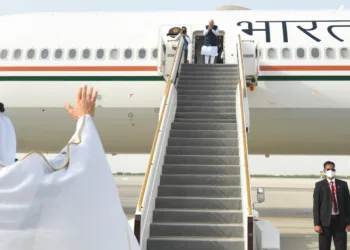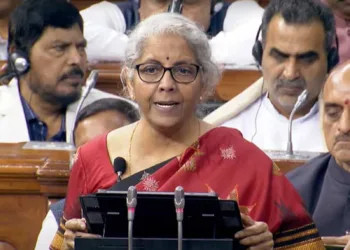Buoyed by a massive capex boost from the government, the civil aviation sector in India is set to witness robust growth, spawning investment opportunities for both domestic and foreign entities
BY B. SHEKHAR
The first industry which nosedived during the Covid-19 pandemic was the aviation sector. The impact was so severe that every service related and associated with the aviation industry simply came to a standstill.
Pre-2020, the aviation industry which was cruising above the clouds with a compounded annual growth rate (CAGR) of double digits suddenly plummeted to the ground. The entire value change associated with the aviation industry vis-à-vis original equipment manufacturers (OEMs) of aircraft, lessors, air navigation service providers (ANSPs), airports, catering operations, ground services, maintenance, repair, and overhaul (MRO), airlines, freight forwarders and global distribution system (GDS) and related sectors took a hit, causing haemorrhage approximating $168 billion in economic losses in 2020-21.
The pandemic wreaked financial devastation across the aviation value chain except for freight forwarders and cargo airlines, which in fact benefited massively from a rise in demand for air cargo.
But one group of experts says that even prior to the Covid hit on the aviation sector, it was not performing that well.
A recent McKinsey report notes: “Although the COVID-19 pandemic hit airlines harder than any other aviation subsector, it wasn’t doing particularly well before then. From 2012 to 2019, despite a favourable environment of strong economic growth and low fuel prices, airlines were bleeding $17 billion in economic profit a year, on average. Of the 122 carriers we studied, 77 percent were value destroyers. But the average losses of airlines before the pandemic were only around one-tenth of their $168 billion in losses for 2020. Their revenues plummeted by 55 percent, setting the subsector back, in nominal terms, roughly 16 years—to 2004.”
In a little over a century, the aviation industry has gone from learning to fly faster, farther, and running heavier planes to now having 100,000 plus commercial flights occurring around the world each day—representing over 400 departures per hour! Aviation has truly been at the forefront of innovation to become one of the safest and most reliable modes of transportation in the world today.
While the full data from 2021-22 is still unavailable, global consulting firms expect airlines’ 2021 performance to remain weak, with net losses of around 11 percent. The International Air Transport Association (IATA) estimates that even though global revenues for airlines rose by 27 percent last year compared to 2020, they were still 44 percent less than what they were in 2019.
On the customer side, passengers have been holding significant buying power and are mostly price-driven, an added challenge in an age when passengers can easily compare the ticket prices of different carriers online. Despite the best efforts of airlines to differentiate themselves, an airline seat remains relatively commoditised.
If this is the global scenario of the aviation sector, India was no better in this sector as far as operations and financial performance during the Covid period were
concerned.
After air travel was suspended in March 2020, airline operators in India reported losses worth more than ₹19,500 crore while airports reported losses worth more than ₹5,120 crore. Like the global airline industry, several Indian airline companies were also under severe financial stress before the pandemic affected passenger travel. For instance, in the past 15 years, 17 airlines have exited the market. Out of those, Air Odisha Aviation Pvt Ltd and Deccan Charters Pvt Ltd exited in 2020. Air India has been reporting consistent losses over the past four years. All other major private airlines in India such as Indigo and Spice Jet faced losses in 2018-19.

Despite this turbulent scenario, there is a massive rainbow beyond the clouds as India is one of the fastest growing aviation markets in the world. Its domestic traffic makes up 69 percent of the total airline traffic in South Asia. India’s airport capacity is expected to handle one billion trips annually by 2023.
As of June 23, 2020, the Airports Authority of India (AAI) has been operating and managing 137 airports in the country. Domestic air traffic has more than doubled from around 61 million passengers in 2013-14 to around 137 million in 2019-20. International passenger traffic has grown from 47 million in 2013-14 to around 67 million in 2019-20, registering a growth of over 6 percent per annum.
As a result, airports in India are witnessing rising levels of congestion. Most major airports are operating at 85 percent to 120 percent of their handling capacity. In response to this, the government has decided to privatise some airports to address the problem of congestion. AAI has already leased out eight of its airports through Public-Private Partnership (PPP) for operation, management and development on long-term lease basis.
Union Civil Aviation Minister Jyotiraditya Scindia recently said, “In the last five years, we have grown from 2013-14 almost 6 crore passengers to almost 14.5 crore passengers. We forecast by 2027 India will have 40 crore passengers per year. That’s the kind of phenomenal growth and if that phenomenal growth has to be made possible it can only be made possible by a number of players coming into the sector.”
While G.P. Rao, former general manager of Air India, says, “India is seeing a phenomenal revival post-Covid restrictions though the industry started very slow but it picked up momentum and is in full swing. Soon, we are expecting that India will overtake the UK and become the third largest player. With the Ude Desh ka Aam Naagrik (UDAN) scheme in place, airlines started operating more than 600 routes and because of this more than 10 million people benefitted.”
Under the Regional Connectivity Scheme UDAN, AAI, the implementing agency, has awarded 948 routes, of which 405 routes involving 65 airports have been operationalised as of March this year. With more routes and airports opening up, the airline industry is set to witness robust growth. This in turn will spur investment opportunities for the country, thereby creating employment potential as well. The aviation sector is another rapidly developing story of Brand India.
INDIAN AVIATION OUTLOOK
The Indian aviation industry has recovered to a large extent from the Covid-19 pandemic shock as indicated by the air traffic movement which stood at 6,13,566 in the first quarter of FY 2022-23 compared to 3,00,405 in the same period last year, an increase of 104.24 percent.
Indigo is the largest airline company in India with the highest market share. Further, the rising demand in the sector has pushed the number of airplanes operating in the sector. The number of airplanes is expected to reach 1,100 by 2027.
India’s passenger traffic stood at 188.89 million in FY22 and 76.47 million in the first quarter of FY 2022-23. In FY22, airports in India pegged the domestic passenger traffic to be 166.8 million, a 58.5 percent YoY increase, and international passenger traffic to be 22.1 million, a 118 percent YoY increase, as compared to FY 2020-21.
According to McKinsey estimates, by the mid-2030s, no fewer than 200,000 flights per day are expected to take off and land all over the world. As the industry plans to support a near doubling of passenger and cargo numbers by 2036, demand for pilots, engineers, air traffic controllers and other aviation-related jobs is expected to rise dramatically. What is also certain is that innovations in technology and approaches will be needed to sustain this growth.
In conclusion, buoyed by the massive growth potential, the Indian civil and cargo sectors are expected to witness ₹35,000 crore ($ 4.99 billion) investment in the next four years. The government is planning to invest $1.83 billion for development of airport infrastructure along with aviation navigation services by 2026. India aims to have 220 new airports by 2025. Cargo flights for perishable food items will also be increased to 30 percent, with 133 new flights in the coming years.
The writer is a Bengaluru-based business journalist associated with IMS Foundation.








